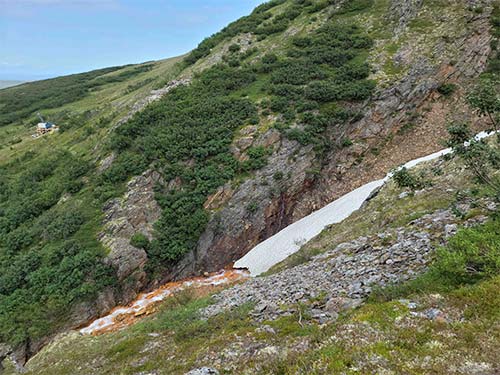










 Contact Contact 
 Webmail
Letters Webmail
Letters
 News Tips News Tips
 Copyright Info Copyright Info
 Archives Archives
Quick News
Search
 Alaska Alaska
 Ketchikan Ketchikan
 SE Alaska SE Alaska
Columns
- Articles
 Dave Kiffer Dave Kiffer
 Money Matters Money Matters
Historical
Ketchikan
 June Allen June Allen
 Dave
Kiffer Dave
Kiffer
 Louise
B. Harrington Louise
B. Harrington
Sports
 Ketchikan Links Ketchikan Links
Public Records
 FAA Accident Reports FAA Accident Reports
 NTSB
Accident Reports NTSB
Accident Reports
 Court Calendar Court Calendar
 Recent Filings & Case Dispositions Recent Filings & Case Dispositions
 Court Records Search Court Records Search
 Sex Offender Reg. Sex Offender Reg.
 Public Notices Public Notices
 Alaska Recall Alerts Alaska Recall Alerts
 Recalls.gov Recalls.gov
 AST Daily Dispatch AST Daily Dispatch
 KTN
Police Reports KTN
Police Reports
 Juneau Police Reports Juneau Police Reports
Weather,
Webcams
 Today's
Forecast Today's
Forecast
 KTN
Weather Data KTN
Weather Data
 AK
Weather Map AK
Weather Map
 AK Weathercams AK Weathercams
 AK Earthquakes AK Earthquakes

|

Saturday
April 15, 2023
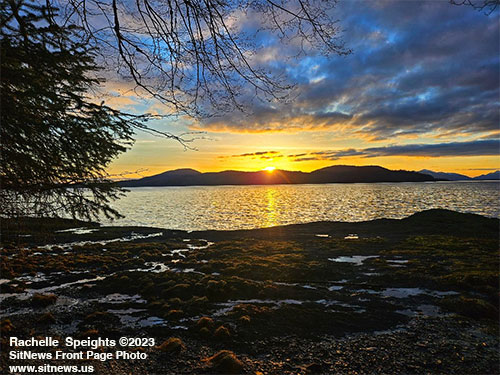
Sunset: Settler's Cove
SitNews Front Page Photo By RACHELLE SPEIGHTS ©2023
To have your photo(s) featured on the front page,
email your photo(s) to editor@sitnews.us |
|
Ketchikan Historical: ‘Ketchikan’ still has two buildings from the 1800s By DAVE KIFFER -
It is a commonly asked question.
If Ketchikan has more "historic" properties than any other community in Alaska, which is the oldest building?
It depends on how you define "Ketchikan."
The answer is different if you mean the City of Ketchikan or the Ketchikan Gateway Borough. It's also different if you define "Ketchikan" as the areas of the community that are on the road system.
Ketchikan indeed has more "historic" properties than anywhere else in Alaska, primarily because Ketchikan has a very high number of buildings built in the 1910s and 1920s that are still in use.
Anything more than a century old in Alaska can rightly be called "historic." And Ketchikan has a very high per capita number of buildings that are actually on the National Register of Historic Properties.
But the question also arises over which building is actually the oldest. Ketchikan did not become an official city until 1900 and its earliest development dates from the mid 1880s, so as a community its oldest existing buildings pale in comparison to structures in Kodiak and Sitka which date from 1800.
Even the adjacent community of Saxman has at least one building that is "older" than anything in Ketchikan proper.
But to find the oldest building in the Ketchikan Gateway Borough, you need to go a little farther afield. Not off Revillagigedo Island, but definitely off the road system.
The community of Loring began in the early 1880s as the location of a major cannery. In fact, it was a much larger community than Ketchikan into the early 1900s.
In fact, if it had been successful in getting the Federal Government to relocate the Mary Island Customs Station - the official entry point for all vessel traffic from the South - to Loring rather than Ketchikan, the subsequent history of both communities would have turned out differently and Loring could have developed into the primary community in Southern Southeast Alaska.
But Ketchikan won that battle and now Loring - which lost its cannery a century ago - is a collection of less than a dozen small buildings.
But one of those buildings is the answer to the question, what is the oldest building in "Ketchikan."
Although it was not the first building built in Loring, the so-called "Heckman House" was built in 1885 and still exists, making it the oldest building in Ketchikan, if you mean the Ketchikan Gateway Borough, which includes Revilla, Gravina and Duke islands, as well as a large swath of the mainland from the Canadian border northward, although not the communities of Meyers Chuck and Hyder.
The Heckman House is a three-bedroom, 1,000 square foot house that was built for one of the early cannery superintendents. Although it has been expanded over the years, parts of the building date to 1885. It is - and the one-acre property around it - is currently for sale. It is not on the national register.
Now, there are those that say that Loring is "not Ketchikan" which is true. But before we get to the oldest building in Ketchikan, we need to address Saxman, which is only two miles south of Ketchikan on the road system.
The oldest existing building in the City of Ketchikan dates from 1899, so there is at least one building in Saxman which dates from the founding of that community in 1895, the school house/town hall building along the South Tongass Highway. Up until recently, there were two buildings of a similar age in Saxman as the Chief Shakes House also dated from 1895, but the Shakes house - which had been abandoned for decades - finally succumbed to the elements in 2021.
The future of the school house was also in question recently when Saxman considered a proposal to tear it down and built a new community facility and store on its site. But that proposal was shelved when it was decided to build the store at the Saxman Seaport instead. - More...
Saturday - April 15, 2023
|
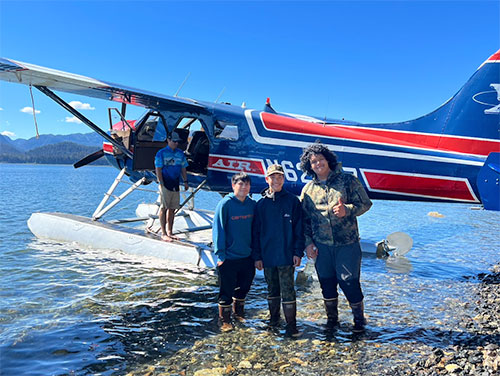
Crossing Kootznoowoo - and exploring
potential career paths
By MARY CATHARINE MARTIN
From left to right, Sam Fredrickson, Trevor Fredrickson and Beebuks Kookesh as they board the Ward Air floatplane that would return them home, to Angoon, after paddling and hiking the cross-Admiralty canoe route.
Photo by MARY CATHERINE MARTIN ©2023 |
|
Southeast Alaska: Crossing Kootznoowoo - and exploring potential career paths By MARY CATHARINE MARTIN - The 30-mile Cross-Admiralty Canoe Route could be seen as a straightforward trip: start in Angoon (Aangóon, or “isthmus town”), where Tlingit people have lived since time immemorial. Travel to the head end of the at-times treacherous Mitchell Bay, don backpacks, hike into the rainforest and portage and paddle a series of Admiralty Island’s lakes, until you get to Mole Harbor, on the other side of the island. Along the way, you may fish for cutthroat trout; you may see brown bears. You’ll clamber over slippery logs and use them to cross beaver-flooded sections of trail. You’ll glimpse deer along the lakeshore. You’ll see flickering schools of juvenile fish, eat wild mint, and you may get a few new blisters and calluses.
In another sense, however, the cross-Admiralty Island trip — which three Angoon high schoolers, two Southeast Alaska Expeditions guides, and a couple of storytellers, myself included, did for the first time last August – is much more than that. It’s Angoon’s backyard, and a portal into the interior of the island. Our trip was the first of what will hopefully be regular trips across the island for Angoon residents and Kootznoowoo, Inc shareholders. It was an introduction to a potential career in land stewardship for the three youth on the trip. And it was one of the first projects funded by the USDA’s Southeast Alaska Sustainability Strategy, a new approach in Southeast Alaska that finds ways to support community and Indigenous-led sustainable economic development and land management.
Day 1 - Mitchell Bay to Davidson Lake
Beebuks Kookesh, Sam Fredrickson, and Trevor Fredrickson, all friends, cousins, and Angoon high schoolers, met the four of us adults who were along to guide and document the trip — Haines-based Southeast Alaska Expeditions guides Beth Fenhaus and Jeff Moskowitz, U.S. Forest Service and Sitka Conservation Society storyteller and videographer Lee House, and myself — at the head end of Mitchell Bay, where we had all been transported by Beebuks’ father, Ed Kookesh. Along the way, Ed pointed to historically important places and trees downed by windstorms the previous winter.
I’ve talked to people who have done the route who say the first four-mile portage from Mitchell Bay to Davidson Lake isn’t very difficult. The previous winter’s windstorm must have complicated things, because that first portage isn’t something I would describe as “easy.” Downed trees lay across the trail, especially in the last couple of miles. We had to clamber over them or squeeze ourselves and our packs along the ground under them. One of the crossings had flooded due to beaver activity, and while crossing a slippery log set over a waist-deep beaver slough, one of us slipped backward and got soaked. (Only Beebuks still had dry X-tra Tuffs at the end of the trip.)
Darkness caught us before we were where we planned to camp that first night. We pulled out our headlamps, contemplated and rejected the idea of camping amid a bunch of blowdown, scarfed handfuls of dried fruit and jerky, refilled our water bottles at a muskeg pond and began what would become one of the most iconic parts of the trip — listening to music provided by Sam, dubbed “DJ Bear Scare” — by the time we arrived at Davidson Lake around 9 p.m. Things just don’t feel the same when 2Pac is your soundtrack.
At Davidson, Beebuks immediately got out his fishing pole and began to cast. - More...
Saturday - April 15, 2023
|
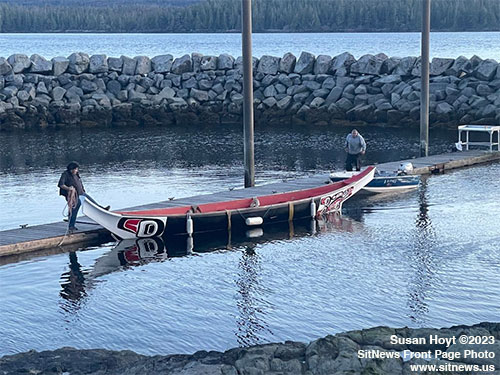
ON THE MOVE
Native people of Southeast Alaska developed highly sophisticated canoes adapted to their uses. This canoe was photograph as it was on the move to Saxman for display.
SitNews Front Page Photo By SUSAN HOYT ©2023
To have your photo(s) featured on the front page,
email your photo(s) to editor@sitnews.us |
|
Alaska: U.S. District Court Rules Against Feds on WOTUS - The U.S. District Court for the District of North Dakota on April 12, 2023 issued a preliminary injunction against the federal government from implementing a new rule redefining Waters of the United States, also known as WOTUS. The flawed rule would act as another bar to landowners (including the State) who wish to improve or develop their land even if that property sits miles away from a traditional navigable waterway.
“It’s good news to see the Court recognize that Alaska needs regulations tailored to the diversity and abundance of its waters, not a one-size-fits-all rule imposing excessive federal requirements,” said Alaska Governor Mike Dunleavy. “Alaska stands to be disproportionately affected by the new rule, and particularly, by the vast expansion of federal jurisdiction it would inflict on states.”
The Clean Water Act was passed to protect the nation’s waters. It requires permits to discharge pollutants from point sources into “navigable waters,” and it requires permits to discharge dredge and fill material into “navigable waters.” Both are key for development in Alaska to proceed. The statute defines “navigable waters” as “waters of the United States, including the territorial seas.” The federal government’s new rule redefined “waters of the United States” to include non-navigable purely intrastate waters.
The preliminary injunction applies to the 24 states that sued the federal government.
“I am glad the District Court saw the harm to the states that would come from implementing this rule,” said Attorney General Treg Taylor. “Its massive breadth and vagueness would lead to a lot of unnecessary uncertainty for not only the state but also companies seeking to do business in Alaska. This is especially troublesome when the Supreme Court will be ruling on a case that may give us all some clarity on what waters are covered by the Clean Water Act in the next couple of months. We are hopeful that decision alone will force the EPA to re-think the rule and really get back to the original intent of Congress when the Clean Water Act was passed.” - More...
Saturday - April 15, 2023
Alaska: Bethel Superior Court Judge Dismisses Challenge to ADFG Management of Chum and King Salmon - A Superior Court Judge in Bethel granted the Alaska Department of Fish & Game’s motion to dismiss Monday in Forrer v. State. The plaintiff, Eric Forrer, had alleged that the Department’s management of the Yukon and Kuskokwim king and chum salmon runs had historically violated the sustained yield clause of the Alaska Constitution.
These allegations did not challenge any specific inseason management decision or regulation. The Department has managed and will continue to manage Alaska’s fisheries for a sustained yield.
Mr. Forrer asked the Court to “invalidate six decades of policy and admonish an agency based on nothing more than personal observations of one individual and scant, tenuous factual claims.” The Court stated “[t]his is something [it] cannot do.”
The Department of Fish and Game argued for dismissal because there was no dispute that the Department manages the Yukon-Kuskokwim fisheries consistent with the sustained yield mandate found in the Alaska Constitution.
“The State’s inseason management, area management plans, and statewide regulations reflect the Department’s world-renowned science-based fisheries management” said Alaska Department of Fish and Game Commissioner Doug Vincent-Lang. “Over the last two years, the Yukon and Kuskokwim fisheries have faced historically low salmon runs and the Department has managed the fisheries to preserve the stocks in the face of this crisis.” - More...
Saturday - April 15, 2023
Alaska: Two Alaska Tribal Organizations Sue the Federal Government to Protect Subsistence Fishing as the Salmon Crisis Intensifies - The Association of Village Council Presidents (AVCP) and Tanana Chiefs Conference (TCC), represented by Earthjustice, have filed a lawsuit against the National Marine Fisheries Service (NMFS) in U.S. District Court in Alaska, seeking to reexamine groundfish catch limits for the Bering Sea and Aleutian Islands.
AVCP and TCC collectively work on behalf of nearly 100 Tribes and communities in the Yukon-Kuskokwim region.
The lawsuit alleges that when NMFS recently adopted groundfish catch limits for 2023-2024, the agency unlawfully relied on outdated environmental studies and failed to consider monumental ecosystem-wide changes that have occurred in the Bering Sea and Aleutian Islands ecosystems over the last two decades.
Quoting a news release, Alaska is facing a historic salmon crisis which is crushing the people and tribes of Western Alaska. Subsistence fishing in the Yukon and Kuskokwim regions of the state has been severely restricted for over a decade while the pollock trawl fishery continues to catch thousands of Chinook and chum salmon as bycatch each year. Meanwhile, radical ecosystem changes have negatively affected conditions for Chinook and chum salmon rearing in the ocean. The federal government’s current fisheries management decisions prioritize maximizing groundfish catch over protecting the subsistence rights of Alaska Native peoples who are deeply impacted by those decisions.
Despite these sweeping ecosystem changes and their dramatic effects on people in the region who depend on the marine environment, NMFS set groundfish catch limits based on analyses well over a decade old. These rapid and unprecedented ecosystem changes are relevant to fisheries management decisions and defendants cannot make informed decisions based on severely outdated studies, states the news release.
AVCP Chief Executive Officer Vivian Korthuis said, “This litigation is intended to hold the government accountable for its lack of action, lack of urgency and lack of understanding that as our environment changes, catastrophic impacts are occurring in our waters. This lawsuit has been brought to protect the subsistence way of life which is critical to the health and well-being of the tribes of the Yukon-Kuskokwim region. The federal government continues its ‘business as usual’ deliberate and ineffective management style as our people suffer and our waters are forever harmed.” - More...
Saturday - April 15, 2023
|
|
Alaska: Northern Star (Pogo) LLC penalized $600,000 for hazardous waste management violations - The U.S. Environmental Protection Agency announced this week that Northern Star (Pogo) L.L.C. was fined $600,000 for improper storage, treatment, and disposal of hazardous materials at its gold mine and laboratory in Delta Junction, Alaska.
"Strict accountability for hazardous waste is vital to protecting people and the environment at every step of the way," said EPA Region 10 Office of Enforcement and Compliance Assurance Acting Director Stacy Murphy.
Murphy said, “Companies are required to take responsibility for these materials for their entire lifespan and must be held accountable for failing to do so.”
Following an inspection in 2019, EPA cited Northern Star (Pogo) L.L.C. for 81 violations of the Resource Conservation and Recovery Act, including:
• Failure to determine if waste from laboratory testing was hazardous waste.
• Treatment, storage, and disposal of hazardous waste without a permit.
• Storage in two unlabeled 762-gallon belowground tanks, which accumulated hazardous wastes from laboratory tests. The tanks did not meet design and installation requirements, and lacked both secondary containment and a leak detection system.
• Disposal of about 364,450 tons of waste in the gold mine without proper treatment. - More...
Saturday - April 15, 2023
Alaska: Department launches new effort to support Alaska's refugees and "legal aliens" - The Alaska Department of Labor and Workforce Development (DOLWD) is standing up the Office of Citizenship Assistance within the Commissioner's Office to assist Alaska's refugee and migrant communities. The office will be led by Deputy Commissioner Nelson San Juan who is returning to the Department for this role. He retired from state service last September.
AS 23.05.125 outlines the role of this office, to help coordinate training and employment services for "legal aliens" who are in Alaska.
Additionally, Deputy Commissioner San Juan will be working directly with Alaska employers to connect Alaskans to employment.
According to Catholic Social Services, more than 500 Ukrainian refugees immigrated to Alaska last year, and hundreds more are expected this year. Deputy Commissioner San Juan will be working on resettlement efforts, providing assistant for those seeking employment, training, and connections with Alaska employers. - More...
Saturday - April 15, 2023
Alaska: Suspected overdoses - The Alaska State Troopers have responded to several suspected overdoses this month in the Mat-Su area. According to a news release, law enforcement believe that a lethal batch of illegal drugs is currently circulating in the Mat-Su, causing the rise in overdose events. At this time, at least three people are believed to have died as a result of drugs likely containing fentanyl, and at least 11 other overdose emergencies have been reported to law enforcement, since April 1.
While the use of illegal drugs such as heroin and methamphetamine is always discouraged, law enforcement encourages anyone who uses illegal drugs in the Mat-Su area to take extra caution at this time, due to high levels of potency in current circulation. - More...
Saturday - April 15, 2023 |
|
Alaska: Research reveals geologic history of critical Alaska graphite deposit By ROD BOYCE - A University of Alaska Fairbanks researcher is among the scientists who have revealed the metamorphic history of a high-grade graphite deposit on the Seward Peninsula. The Graphite Creek deposit is among the largest known of its kind in the United States.
Graphite is used in lithium-ion batteries, which power modern portable electronics, electric vehicles and renewable energy storage systems.
“This gives us a better understanding of how the rock evolved and how the processes affected the rocks’ texture and mineralogy over time,” said petrologist Sean Regan, an assistant professor of geology at the UAF Geophysical Institute and at the UAF College of Natural Science and Mathematics.
“Knowing that can help with exploration,” he said.
The United States extracts no graphite of its own. The nation imports one-third of its graphite from China, with Canada and Mexico among other suppliers.
The federal government has listed graphite as a critical mineral.
The researchers’ findings can guide development of Graphite Creek by Graphite One, the company behind the mining project. The Federal Permitting Improvement Steering Council in January 2021 designated Graphite Creek as a high-priority infrastructure project.
A research paper published Feb. 27 in the journal Mineralium Deposita defines the age and characteristics of the deposit and provides information geologists can use to understand other potential graphite sites.
George Case of the U.S. Geological Survey in Anchorage is the paper’s lead author. Regan is among the eight co-authors.
Geologists have had little understanding of the processes that lead to creation of high-grade flake graphite. That lack of understanding has been a barrier to evaluating such deposits for exploration and development.
“To really understand the system, you need to understand everything that’s going on. You need to incorporate tectonics, timing, petrology and structural geology,” Regan said. “All of those things need to make sense together because it’s a system.” - More...
Saturday - April 15, 2023 |
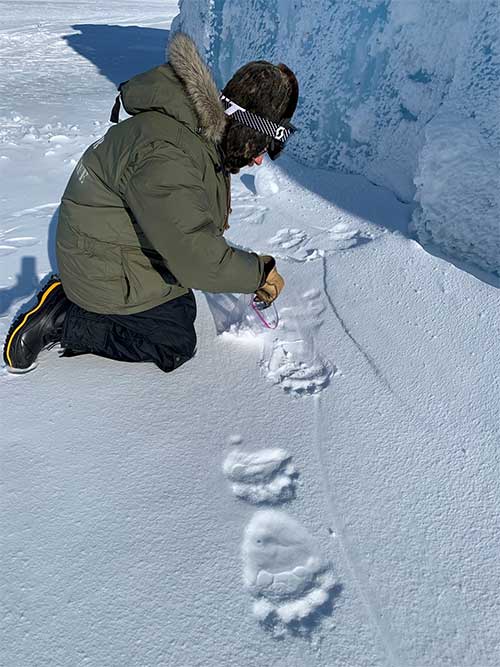
Identifying polar bears by their footprints
By NED ROZELL
Wildlife technician Pete Detwiler of the North Slope Borough Department of Wildlife Management samples polar bear tracks north of Utqiagvik in April 2021 for a project to identify bears by the DNA left behind in their footprints.
Photo by Craig George |
| Alaska: Identifying polar bears by their footprints By NED ROZELL - Scientists in northern Alaska are learning about polar bears by scraping snow samples from the tracks they leave behind.
That snow contains tiny flecks of the massive creatures — mostly cells shed from their foot pads. From the DNA within those cells, scientists have been able to identify individual polar bears. That helps them learn more about the farthest-north bears without bothering them or taking extreme risks in the name of science.
Lisette Waits of the University of Idaho was in Fairbanks recently at a conference to talk about a wildlife-sampling method that does not include a helicopter, dart gun or handling of a drugged polar bear that can weigh as much as four NFL linemen.
In her genetics lab in Moscow, Idaho, Waits and her colleagues have processed melted snow skimmed from polar bear tracks in Utqiaġvik, Wainwright and Kaktovik. That broth includes some cells that have allowed scientists to get a DNA fingerprint of a particular polar bear.
Scientists want to find out more about an animal dependent on northern sea ice, a substance that has been steadily decreasing for as long as we’ve had a good look at it. Polar bears use sea ice as a platform for hunting ringed seals, the fatty staple of their diets.
Polar bears of the northern sea ice number from about 20,000 to 30,000 animals, with the waters and shorelines of northern and western Alaska supporting an unknown number. Scientists have identified two populations of polar bears in Alaska: a Chukchi Sea group that also expands to Russia and Beaufort Sea animals that extend into northern Canada. - More...
Saturday - April 15, 2023
|
PETER ROFF: YOU CAN’T TAX YOUR WAY BACK TO PROSPERITY - t’s tax season again and, with the possible exception of President Joe Biden and a few members of Congress, we’re not happy about it.
Overall, thanks to the 2017 Tax Cuts and Jobs Act, the federal tax bill many of us will pay is down from what it might have been. Biden thinks that’s a problem, even though tax revenues soared as a result of the lower rates. His core economic message continues to be that the wealthiest among us need to pay more even though the IRS data shows they are. After the tax cuts became law, tax payments by the top 1% of income earners rose by 17.3%.
What Biden and the other Democrats won’t admit is that by “more” they don’t mean just more than everybody else. They mean “more” much in the way Karl Marx did when he wrote about the distribution of resources: “From each according to his ability, to each according to his needs.”
For Marx, it was a matter of abundance. He believed the economic system he advanced would produce enough for everyone. We know how that turned out. Biden and his fellow travelers likewise see abundance unequally distributed but call it “income inequality.”
To address it, they want to impose a wealth tax, tax unrealized capital gains, and levy higher taxes on incomes above a certain amount. They’re for just about everything that would transfer more of the assets of the so-called rich to Washington so they could redistribute it – enlightened progressives that they are – to the poor, the needy, and the favored. - More...
Saturday - April 15, 2023
TOM PURCELL: WILL’S WIT SOOTHES A TAXING TIME - Tax returns are due next week [Tuesday - April 18, 2023] and many Americans are surely stressed out as they scramble to get their financial records in order.
I can’t think of a better time to revisit the wit and wisdom of Will Rogers.
Rogers was a famous American humorist, actor and social commentator who lived from 1879 to 1935, when he died in a plane crash.
He was known for his folksy wit and common-sense observations, which he published in his syndicated newspaper column — observations such as these:
“The only difference between death and taxes is that death doesn’t get worse every time Congress meets.”
“If you make any money, the government shoves you in the creek once a year with it in your pockets, and all that don’t get wet you can keep.”
“The crime of taxation is not in the taking it, it’s in the way that it’s spent.”
Will, your words still hold true some 90 years after you spoke them.
Taxes are going up.
Millions are taking a bath in the creek as our government empties our pockets.
And not only do I not like the way our tax money is being spent, I especially dislike the way politicians are spending the trillions we keep borrowing and adding to the national debt. - More...
Saturday - April
15, 2023
FINANCIAL FOCUS: Investment ideas for business owners Provided By BEN EDWARDS, AAMS® - By definition, business owners put a lot of their financial resources into their enterprises. But as an owner, you may need to invest in more than inventories and payroll to help achieve the future you’ve envisioned.
Here are a few investments you may want to consider:
• Retirement account – Depending on the nature of your business and how many employees you have, you can choose from a variety of tax-advantaged retirement plans, such as an owner-only 401(k), an SEP-IRA and a SIMPLE IRA. By contributing regularly to one of these accounts, you can avoid being entirely dependent on the sale of your business to pay for your retirement years.
To fund your 401(k) or other retirement plan, you’ll have many investment options — stocks, bonds, mutual funds and so on. And if you “max out” on your retirement plan, you may even be able to build a separate investment portfolio. In any case, keep in mind that you’re already putting a lot of money into your business, so, to achieve a level of diversification, you may want to concentrate your investment choices in areas outside your industry. However, while diversification can help reduce the impact of market volatility on your portfolio, it can’t guarantee profits or protect against losses in a declining market. - More...
Saturday - April 15, 2023
|
POLITICAL CARTOONS

Political Cartoon: Classified Documents Leak
by Dick Wright©2023, PoliticalCartoons.com
Distributed to subscribers for publication by CagleCartoons.com

Political Cartoon: Leaked Documents
by Gary McCoy, Shiloh, IL
Distributed to subscribers for publication by CagleCartoons.com

Political Cartoon: No one Above the law
by Rivers©2023, CagleCartoons.com
Distributed to subscribers for publication by CagleCartoons.com

Political Cartoon: Procrastination Nation
by John Darkow©2023, Columbia Missourian
Distributed to subscribers for publication by CagleCartoons.com

Political Cartoon: Keep Digging
by Rivers©2023, PoliticalCartoons.com
Distributed to subscribers for publication by CagleCartoons.com |
GIVE US BACK OUR FERRY TO PRINCE RUPERT By Mary Lynne Dahl - Ketchikan, her close community neighbors and all of Southeast Alaska are in danger. We are at risk of losing our AMHS ferry run to Prince Rupert, BC (YPR) permanently, if we do not make it known, loud and clear, to the State of Alaska that we need to have ferry service to YPR on a regular basis.
Ferry service to Prince Rupert is vital. Because Ketchikan is a roadless community, it is the only way we can reach the mainland quickly at a reasonable cost. Bellingham is too far, takes too long and is far too expensive for residents to use. Prince Rupert is less than a 7-hour trip vs. a 44 hour trip to Bellingham. The fare to Prince Rupert is approximately $400 for a Subaru, driver, 1 passenger and a dog one-way, while the fare for the same folks to Bellingham is just under $2,000 one-way. How many local residents of Southeast Alaska can afford to spend $2,000 just to get to the mainland and then spend it again just to get home?
Not everyone wants to get to the mainland in order to go south anyway. Many of us want to spend the time in BC. My family has no interest in taking an expensive 2-day, 600 mile ferry trip south to Bellingham from Ketchikan, get off the boat and drive north 700 miles to our destination of Smithers. Others head east to Spokane, Idaho, Montana and other Canadian provinces. Locals heading to Seattle usually fly, not ferry.
100% of the numerous people I have talked to have said they want the Prince Rupert ferry run and will not/can not afford to use the Bellingham ferry to get to the mainland. They have said that they feel trapped, neglected and ignored by the ferry system. Several have said they are considering moving away and some have already left. They liken it to being the “unloved ugly duckling” of southeast communities.
DOT claims that they cannot afford to sacrifice any of the Bellingham runs to Prince Rupert because: 1. The Columbia cannot dock in Prince Rupert, 2. The Kennicott requires more crew than they have, 3. The Matanuska is in need of steel replacement and DOT does not want to spend the money to do the job.
I have listened to all of the excuses for not providing service to Prince Rupert. One is that “people do not like to drive through Canada for ‘various reasons’ “. Another is “AMHS gets the most revenue from the Bellingham run”. Is that gross or net revenue? Fuel is about 52% of the cost of ferry service, so the 595 miles to Bellingham burns a lot more fuel than the 90 miles to Prince Rupert, 650% more in fact. Would more 90 mile trips to YPR that burn less fuel produce more revenue than trips to Bellingham? I would like to see the math. Further, ridership from Bellingham is declining and has been since 2013; at last count it was down almost 20% (source: AMHS annual reports). - More...
Saturday - April 15, 2023
 |
Alaska Marine Highway System By A. M. Johnson - Regarding the various comments to question #1 and #2 related to the Alaska Marine Highway presented in the weekend edition of the Ketchikan Daily News, April 1, in summation after reading the various collection of talking heads feeding us hicks with platitudes and cake, Former Governor Murkowski cut to the chase with sound solutions He recognized the multiply past advisory groups which have produced confusion complete with no further advancement reflecting implication or improvements as a result He himself as member of some or all such groups gives him street creed on proposing a copy of an existing example of working success, the Alaska Railroad commission. Now I admit that if there are flaws within that organization, I am unknowing, however the principal of that process if amendable is worth proceeding to formulation. Governor Murkowski proceeds to point out the original intent of the system being to give Alaskans access to a road. That "Road" is Prince Rupert South and Haines or Skagway North. Seattle ,then Bellingham was a political outcome that said the hell with what Alaskans desire. Reminiscent of the fish traps existence by outside ownership resulting in a big part, Statehood action, similar forces brought about these two distant port decisions.
Former Governor Mackowski continues with solutions, in effect, (paraphrasing) cut the focus on Bellingham and serve Prince Rupert. How can this not be obvious. First, Alaskans would once again have an affordable route fiscally and of choice in terms of where and what in their travels they desire to make decisions on. Second, the misnomer that "Bellingham is profitable" doesn't pass the smell test when you apply logic, one can assume that the traffic to a more reasonable costing fare would entice more Alaskans to choose the ferry. in relation to this route, the fuel cost of the Bellingham run would be reflected in a huge reduction offsetting the cost of operation with the shorter turn around providing more of the tradition route of yore.
Former Governor Murkowski's advocation of the Prince Rupert to Skagway route and pray mightily that the system can maintain a schedule. With a working fleet of two mainliners that can serve Prince Rupert, chance of disruption without backup vessels is reduced extensively. - More...
Saturday - April 15, 2023
Email your opinions and letters for publication to editor@sitnews.us
|
Articles &
photographs that appear in SitNews may be protected by copyright
and may not be reprinted or redistributed without written permission
from and payment of required fees to the proper sources.
E-mail your news &
photos to editor@sitnews.us
Photographers choosing to submit photographs for publication to SitNews are in doing so, granting their permission for publication and for archiving. SitNews does not sell photographs. All requests for purchasing a photograph will be emailed to the photographer.
|
|











|
|
![]() Contact
Contact ![]()
![]() Webmail
Letters
Webmail
Letters![]()
![]() News Tips
News Tips![]()
![]() Copyright Info
Copyright Info![]() Archives
Archives![]() Alaska
Alaska![]() Ketchikan
Ketchikan![]() SE Alaska
SE Alaska![]() Dave Kiffer
Dave Kiffer![]() Money Matters
Money Matters ![]() June Allen
June Allen![]() Dave
Kiffer
Dave
Kiffer![]() Louise
B. Harrington
Louise
B. Harrington ![]() Ketchikan Links
Ketchikan Links![]() FAA Accident Reports
FAA Accident Reports ![]() NTSB
Accident Reports
NTSB
Accident Reports![]() Court Calendar
Court Calendar![]() Recent Filings & Case Dispositions
Recent Filings & Case Dispositions ![]() Court Records Search
Court Records Search![]() Sex Offender Reg.
Sex Offender Reg.![]() Public Notices
Public Notices![]() Alaska Recall Alerts
Alaska Recall Alerts![]() Recalls.gov
Recalls.gov![]() AST Daily Dispatch
AST Daily Dispatch![]() KTN
Police Reports
KTN
Police Reports![]() Juneau Police Reports
Juneau Police Reports ![]() Today's
Forecast
Today's
Forecast![]() KTN
Weather Data
KTN
Weather Data![]() AK
Weather Map
AK
Weather Map![]() AK Weathercams
AK Weathercams![]() AK Earthquakes
AK Earthquakes

















